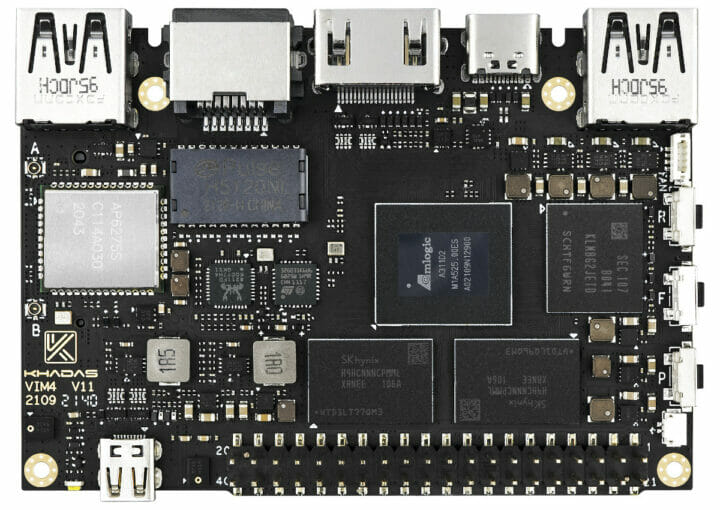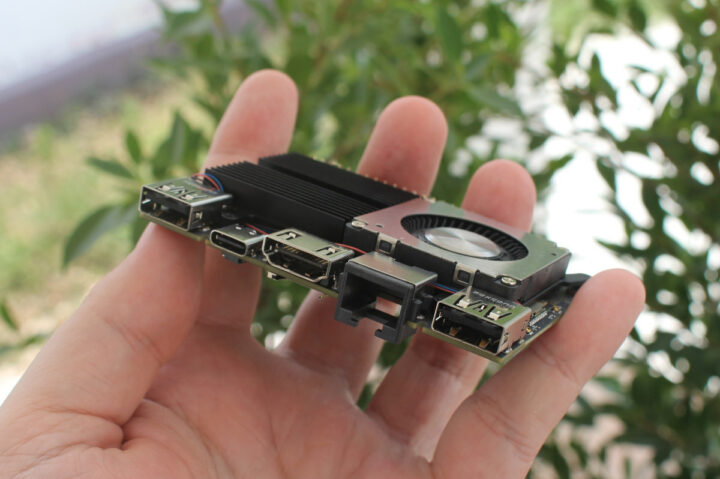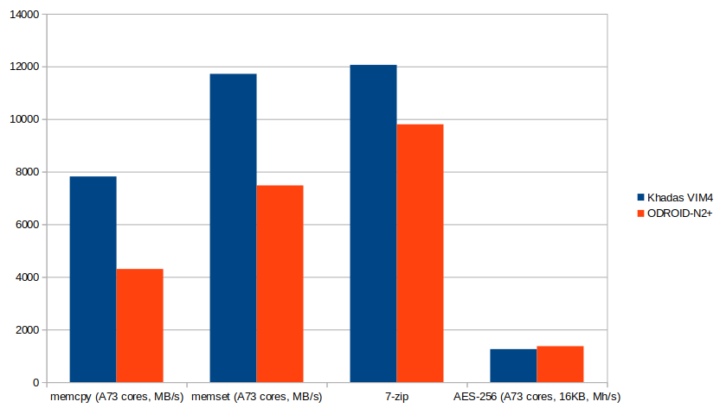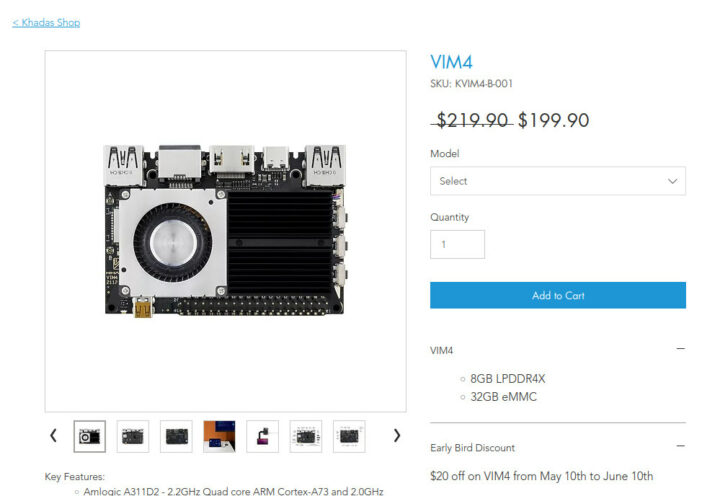Khadas VIM4 single board computer was first unveiled last October with Amlogic A311D2 octa-core Cortex-A73/A53 processor, 8GB LPDDR4X, but it’s only been launched today, and you can now buy the Khadas VIM4 board for right under $200.
It is an upgrade to Khadas VIM3 Pro launched with Amlogiv A311D hexa-core processor a few years ago, and our testing in Android 11 revealed the main benefit may be the upgrade GPU that delivered a 67% boost in 3DMark, but CPU multi-core performance and memory bandwidth will also see some benefits over Amlogic A311D, even against in overclocked systems like ODROID N2+.
Here’s a reminder of Khadas VIM4 specifications:
- SoC – Amlogic A311D2 octa-core processor with 4x Arm Cortex-A73 cores @ up to 2.2 GHz and 4x Cortex A53 cores @ up to 2.0 GHz, Arm Mali-G52 MP(8EE) GPU, (Note: no NPU at this time)
- System Memory – 8GB LPDDR4X @ 2016 MHz
- Storage – 32GB eMMC flash, 32MB SPI flash, microSD card slot, support for M.2 NVMe SSD via the New M2X expansion board
- MCU – STMicro STM32G031 Cortex-M0+ microcontroller @ 64 MHz for power management, customizations, and boot media configuration
- Video Outputs
- HDMI 2.1 up to 4Kp60
- 30-pin 0.5mm Pitch FPC Connector for 4-lane MIPI-DSI interface up to 1920 x 1080
- eDP interface
- LVDS and V-by-One interfaces
- Video Input – 1x Micro HDMI port up to 4Kp60
- Video
- Decoding
- 8Kp24 AV1, H.265, VP9
- Supports multi-video decoding up to 4Kx2K@60fps + 1x1080P@60fps
- HDR10, HDR10+, HLG, and PRIME HDR video processing
- Encoding – 4Kp50 H.265 / H.264 60fps decoder
- Decoding
- Audio – 8-ch I2S for microphone array applications over M2. connector
- Camera – FPC connector for 2x 4-lane MIPI CSI with dual camera support; 16MP ISP
- Connectivity
- Gigabit Ethernet with WoL support
- Dual-band 802.11a/b/g/n/ac/ax WiFI 6, 2X2 MIMO and Bluetooth 5.2 via Ampak 6275S module
- USB – 1x USB 3.0 Type-A port, 1x USB 2.0 type-A port, 1x USB 2.0 OTG type-C port
- Sensor – KXTJ3-1057 3-axis digital accelerometer
- Expansion
- M.2 Socket with single-lane PCIe 2.0, USB 2.0, I2S, I2C, ADC, 100M Ethernet PHY interface, GPIO, MCU_PA2
- 40-pins 2.54mm pitch header exposing:
- CPU signals – USB, I2C, I2S, SPDIF, UART, PWM, ADC
- MCU signals – SWIM, NRST, PA1
- Misc – RTC & battery header; 4-pin cooling fan header with PWM speed control; 3x user LEDs; power, function and reset buttons; XPWR pads for an external power button
- Power Supply – 5V to 20V via USB-C port or pogo pads
- Dimensions – 82.0 x 58.0 x 13 mm (4x M2 mounting holes)
My VIM4 board shipped with a heatsink and PWM fan that keeps it cool under load. It is turned off most of the time even in a room with a 28°C ambient temperature, and I found it very quiet when it is triggered under load.
The company also offers a variety of optional accessories, some of which you can find in our Khadas VIM4 unboxing:
- VIMs Heatsink
- 3705 Cooling Fan
- TS050 Touch Screen
- New M2X Extension board for M.2 SSD and/or M.2 4G LTE modem
- RTC Battery
- USB-C Adapter
- 4G Module
- 5G Module
- M2X WWAN
- VBO LCD Module
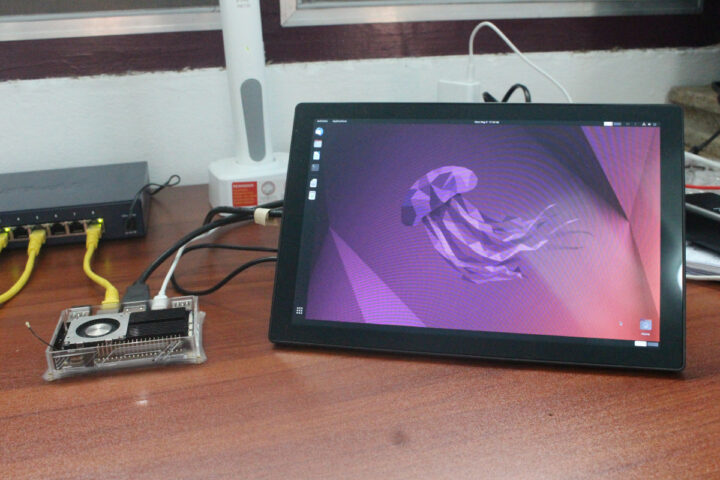
On the software side, Khadas VIM4 board supports the OOWOW system to easily download and install operating systems from the cloud, and currently lists Android 11, Ubuntu 22.04 Desktop, and Ubuntu 22.04 Server. The Android 11 OS is not designed for end-users with an image based on AOSP without services like Google Play, but it offers features like display orientation, micro HDMI input, Wake-on-LAN, and so on.
I’ve just installed Ubuntu 22.04 Desktop, and a full review is coming soon, but in the meantime, I ran sbc-bench.sh to compare it to the benchmark results I got with ODROID-N2+ (Amlogic A311D @ 2.4 GHz):
|
1 2 3 4 5 6 7 8 9 10 11 12 13 14 15 16 17 18 19 20 21 22 23 24 25 26 27 28 29 30 |
sudo /bin/bash ./sbc-bench.sh -c sbc-bench v0.9.4 Installing needed tools. This may take some time..../sbc-bench.sh: line 1328: : No such file or directory Done. Checking cpufreq OPP. Done (results will be available in 14-19 minutes). Executing tinymembench. Done. Executing OpenSSL benchmark. Done. Executing 7-zip benchmark. Done. Checking cpufreq OPP. Done (20 minutes elapsed). Memory performance (different CPU cores measured individually): memcpy: 7816.6 MB/s (0.2%) memset: 11717.9 MB/s memcpy: 2127.4 MB/s memset: 10588.1 MB/s 7-zip total scores (3 consecutive runs): 12016,12028,12132 OpenSSL results (different CPU cores measured individually): type 16 bytes 64 bytes 256 bytes 1024 bytes 8192 bytes 16384 bytes aes-128-cbc 340689.15k 881206.06k 1410492.07k 1649971.88k 1748642.47k 1754764.63k aes-128-cbc 149831.11k 461121.77k 943687.08k 1308184.58k 1472618.50k 1461382.04k aes-192-cbc 319216.09k 796967.81k 1195461.89k 1387976.70k 1458872.32k 1463440.73k aes-192-cbc 143651.73k 414755.01k 777326.76k 1012672.51k 1110059.69k 1117558.10k aes-256-cbc 309348.38k 723233.54k 1063064.92k 1197730.82k 1251726.68k 1255576.92k aes-256-cbc 139829.49k 384315.90k 677202.69k 849066.33k 916553.73k 921638.23k Full results uploaded to http://ix.io/3Xna. |
If we compare both platforms in graphical form, we can see the memory bandwidth is much higher in Khadas VIM4, the 7-zip multi-thread score is also significantly higher, but AES-256 16KB is slower probably because it is a single-threaded benchmark, and the Amlogic A311D2 Cortex-A73 cores run at 2.2 GHz, while the Amlogic S922X Cortex-A73 cores go up to 2.4 GHz in ODROID-N2+. With the CPU temperature never exceeding 58.2°C in sbc-bench benchmark, I suspect Khadas could also provide an image with higher DRAM timing if they wished to.
You can purchase the Khadas VIM4 board now for $199.90 on the company’s store. But that’s without the recommended heatsink and fan, so you may prefer going with the $219.90 “VIM4 Active Cooling Kit” instead. Those are promotional prices with a $20 discount until June 10, 2022.

Jean-Luc started CNX Software in 2010 as a part-time endeavor, before quitting his job as a software engineering manager, and starting to write daily news, and reviews full time later in 2011.
Support CNX Software! Donate via cryptocurrencies, become a Patron on Patreon, or purchase goods on Amazon or Aliexpress


